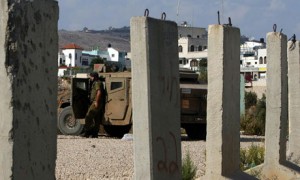Il muro di Berlino sta rinascendo al confine tra Israele e Libano? Una battaglia per evitarlo. La racconta il Guardian del 17,11.2010:
The battle to prevent a ‘new Berlin wall’ on the Israel/Lebanon border
Fears that boundary will ‘divide son and father, brother and sister’ after Israeli troops pull out of northern half of village
Harriet Sherwood in Ghajar guardian.co.uk, Wednesday 17 November 2010 16.42 GMT
At the end of a dusty track, through an Israeli checkpoint and beyond a slalom of concrete blocks, Ahmed Khatib stood on land claimed by three countries, where he fears a new Berlin wall will soon be built.
This is Ghajar, a small village facing a new twist in its complicated geopolitical history. Originally Syrian, it now straddles the border drawn by the United Nations between Israel and Lebanon, but has been occupied by Israel for most of the past 43 years.
Today, the Israeli cabinet approved a plan to withdraw troops from the northern half of the village, which is in Lebanon, while remaining in the southern half, claimed by Israel since it occupied the Syrian Golan Heights during the 1967 six-day war.
The decision has left the residents of Ghajar fearful that families will be divided, residents will be separated from their land, and those living in the northern part will no longer be able to access the village school, mosque and cemetery located in the south.
“Civilised Europe destroyed the Berlin wall,” said Ahmed Khatib, the deputy director of the village council. “Now it will be rebuilt in Ghajar.”
Other residents echoed this fear, pledging to resist any attempt to construct a physical barrier along the “blue line” drawn by the UN 10 years ago to mark the border between Lebanon and Israel.
“We will stop it by all means,” said Shahada Khatib, 26, who travels daily from his home in the north of the village to his job in a bakery in the Israeli town of Kiryat Shimona. “We are ready to sacrifice our souls for that.”
An Israeli official insisted that their fears were misplaced. “We have no intention whatsoever to build a fence or any other kind of physical obstacle through the village on the blue line,” said Ygal Palmor, of the Israeli foreign ministry.
Israel was negotiating with the United Nations interim force in Lebanon (Unifil), which polices the Lebanese side of the border, over security arrangements, he said. “But at no point has anyone raised the possibility of a roadblock or checkpoint inside the village.”
However, a cabinet statement was more ambiguous, saying: “Both the security of Israel’s citizens and the normal life of the residents of Ghajar, which remains undivided, will continue to be maintained while the new arrangements are being put in place.”
Once Israeli troops have pulled back to the southern side of the blue line – a withdrawal expected to take about a month – the UN will declare that Israel is in compliance with security council resolution 1701, said Palmor. “We will have definitively moved out of the last inch of Lebanese territory.”
Israel withdrew from the northern part of the village in 2000, when the border was drawn by the UN, but reoccupied it during its war with Lebanon in 2006. It said Ghajar had become a base for Hezbollah militants and drug traffickers.
The villagers, most of whom are Israeli citizens, strongly identify themselves as Syrian. Today, Ahmed Khatib clutched photocopied documents dated 1958 from villagers petitioning the Syrian authorities to allow the expansion of the village into agricultural land to the north, and the written approval, complete with a Syrian stamp.
“We don’t need the UN, Israel or Lebanon,” he said. “They do not have the authority to decide the destiny of Ghajar. This is Syrian territory.”
The relatively prosperous village is surrounded by a fence, patrolled by Israeli and Unifil troops, with one checkpoint manned by Israeli troops.
According to Khatib, food supplies are brought in by private car as deliveries by truck are not permitted. The Israeli military currently patrols throughout the village.
The village land – 11,500 dunams, or almost 3,000 acres – lies to the south; two-thirds of the 2,210 residents live in the north.
Muheeba Khatib, 40, lives in the north. Her daughter Adla, 25, and two grandchildren live in the south. “We will resist any attempt to split the village. Would you accept to be separated from your daughter?” she said.
Ahmed Khatib points to the village cafe, right on the blue line. You will eat falafel in the south and hamburgers in the north, he says, with bitter laughter.
“This will hurt us economically and socially. They will divide son and father, brother and sister. If the Israelis withdraw [from the northern half of the village], the UN will come here and start building a wall. We know that.”


